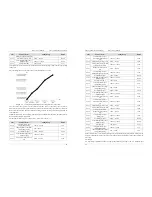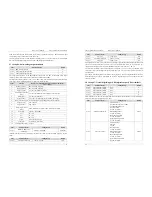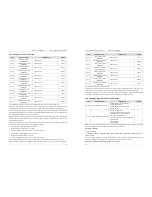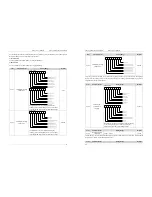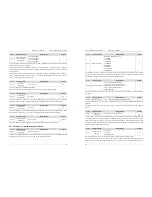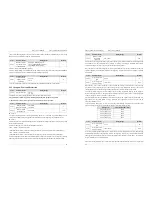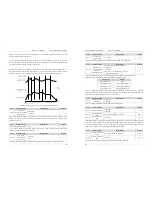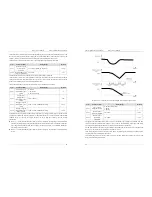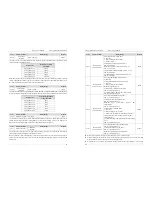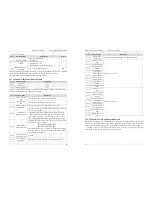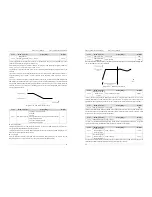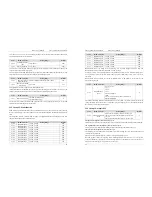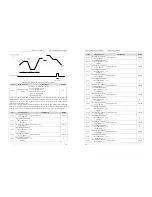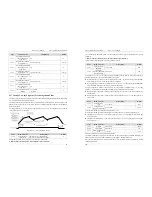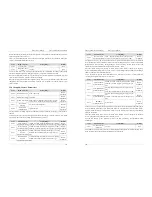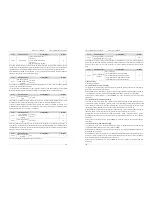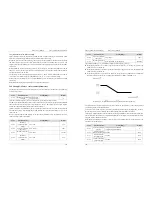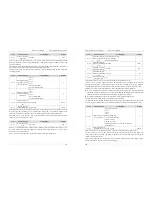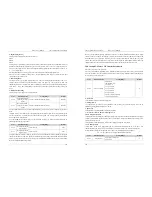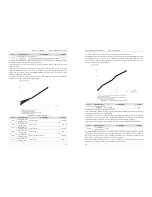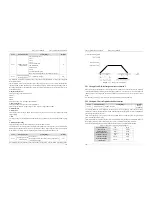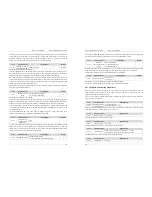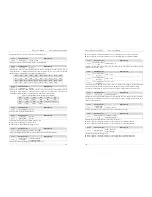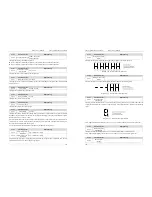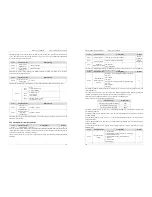
EM11 User’s Manual
5. Description of Function Codes
91
Diagram 6-25 Principle block diagram of PID control.
Code
Parameter Name
Setting Range
Default
C0-00
PID setting source
0: C0-01
1: AI1
2: AI2
3: AI3
4: Pulse setting (DI6)
5: Communication setting
6: Multi-function
0
C0-01
PID digital setting
0.0%~100.0% 50.0%
C0-00 is used to select the channel of target process PID setting. The PID setting is a relative value and
ranges from 0.0% to 100.0%. The PID feedback is also a relative value. The purpose of PID control is to
make the PID setting and PID feedback equal.
Code
Parameter Name
Setting Range
Default
C0-02
PID setting change
time
0.00s~650.00s 0.00s
The PID setting change time indicates the time required for PID setting changing from 0.0% to 100.0%.
The PID setting changes linearly according to the change time, reducing the impact caused by sudden
setting change on the system.
Code
Parameter Name
Setting Range
Default
C0-03
PID feedback
source
0: AI1
1: AI2
2: AI3
3: Pulse setting (HDI)
4: AI1 – AI2
5: AI1 + AI2
6: MAX (|AI1|, |AI2|)
7: MIN (|AI1|, |AI2|)
8: Communication setting
0
This parameter is used to select the feedback signal channel of process PID. The PID feedback is a relative
value and ranges from 0.0% to 100.0%. Similarly, the feedback of PID is also a relative value. The function
of PID is to make the two values the equal.
Code
Parameter Name
Setting Range
Default
C0-04
PID action direction
0: Forward action
1: Reverse action
0
5. Description of Function Codes
EM11 User’s Manual
92
0: Forward action
When the feedback value is smaller than the PID setting, the frequency inverter's output frequency rises. For
example, the winding tension control requires forward PID action.
1: Reverse action
When the feedback value is smaller than the PID setting, the frequency inverter's output frequency reduces.
For example, the unwinding tension control requires reverse PID action.
Note this function is influenced by the DI function 24 "Reverse PID action direction".
Code
Parameter Name
Setting Range
Default
C0-05
PID setting
feedback range
0~65535 1000
This parameter is a non-dimensional unit. It is used for PID setting display (U0-15) and PID feedback
display (U0-16).
Relative value 100% of PID setting feedback corresponds to the value of C0-05. If C0-05 is set to 2000 and
PID setting is 100.0%, the PID setting display (U0-15) is 2000.
Code
Parameter Name
Setting Range
Default
C0-06
Proportional gain
KP1
0.00~10.0 20.0
C0-07
Integral time TI1
0.01s~10.00s 2.00s
C0-08
Differential time TD1 0.000s~10.000s 0.000s
C0-06 (Proportional gain Kp1)
It decides the regulating intensity of the PID regulator. The higher the Kp1 is, the larger the regulating
intensity is. The value 10.00 indicates when the deviation between PID feedback and PID setting is 100.0%,
the adjustment amplitude of the PID regulator on the output frequency reference is the maximum frequency.
C0-07 (Integral time Ti1)
It decides the integral regulating intensity. The shorter the integral time is, the larger the regulating intensity
is. When the deviation between PID feedback and PID setting is 100.0%, the integral regulator performs
continuous adjustment for the time. Then the adjustment amplitude reaches the maximum frequency.
C0-08 (Differential time Td1)
It decides the regulating intensity of the PID regulator on the deviation change. The longer the differential
time is, the larger the regulating intensity is. Differential time is the time within which the feedback value
change reaches 100.0%, and then the adjustment amplitude reaches the maximum frequency.
Code
Parameter Name
Setting Range
Default
C0-09
Proportional gain
KP2
0.00~10.00 20.0
C0-10
Integral time TI2
0.01s~10.00s 2.00s
C0-11
Differential time TD2 0.00s~10.00s 0.000s
C0-12
PID parameter
switchover condition
0: No switchover
1: Switchover via DI
2: Automatic switchover based on deviation
0
C0-13
PID parameter
switchover deviation
1
0.0% ~ C0-14
20.0%




